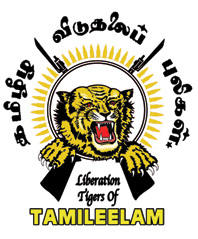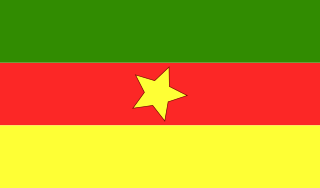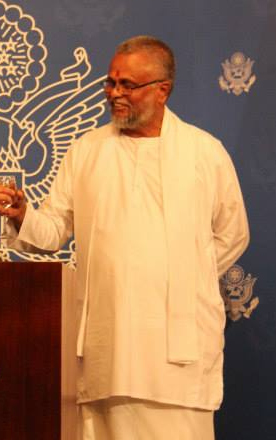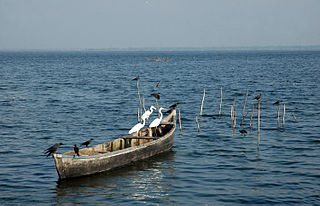
The Liberation Tigers of Tamil Eelam was a Tamil militant organization that was based in northeastern Sri Lanka.

The Sri Lankan Civil War was a civil war fought in Sri Lanka from 1983 to 2009. Beginning on 23 July 1983, it was an intermittent insurgency against the government by the Velupillai Prabhakaran-led Liberation Tigers of Tamil Eelam. The LTTE fought to create an independent Tamil state called Tamil Eelam in the north-east of the island, due to the continuous discrimination and violent persecution against Sri Lankan Tamils by the Sinhalese-dominated Sri Lanka government.

The Tamil National Alliance is a political alliance in Sri Lanka that represents the country's Sri Lankan Tamil minority. It was formed in October 2001 by a group of moderate Tamil nationalist parties and former militant groups. The alliance originally supported self-determination in an autonomous state for the island's Tamils. It supported negotiations with the rebel Liberation Tigers of Tamil Eelam (LTTE) to resolve the civil war in Sri Lanka. The TNA was considered a political proxy of the LTTE which selected some of its candidates even though its leadership maintains it never supported the LTTE and merely negotiated with the LTTE just as the Government did.

The Eelam People's Democratic Party (EPDP) is a political party and a pro-government paramilitary organization in Sri Lanka. It is led by its founder Douglas Devananda.
Sri Lankan Tamil militant groups rose to prominence in the 1970s to fight the state of Sri Lanka in order to create an independent Tamil Eelam in the north of Sri Lanka. They rose in response to the perception among minority Sri Lankan Tamils that the state was preferring the majority Sinhalese for educational opportunities and government jobs. By the end of 1987, the militants had fought not only the Sri Lankan security forces but also the Indian Peace Keeping Force. They also fought among each other briefly, with the main Liberation Tigers of Tamil Eelam (LTTE) rebel group dominating the others. The militants represented inter-generational tensions, as well as the caste and ideological differences. Except for the LTTE, many of the remaining organizations have morphed into minor political parties within the Tamil National Alliance, or as standalone political parties. Some Tamil militant groups also functioned as paramilitaries within the Sri Lankan military against separatist militants.

TamilNet is an online newspaper that provides news and feature articles on current affairs in Sri Lanka, specifically related to the erstwhile Sri Lankan Civil War. The website was formed by members of the Sri Lankan Tamil community residing in the United States and publishes articles in English, German and French.

Kathiravelu Nythiananda Devananda, commonly known as Douglas Devananda, is a Sri Lankan Tamil politician, Cabinet Minister and leader of the Eelam People's Democratic Party. Originally a Sri Lanka Tamil militant who fought against the Sri Lankan government for an independent Tamil Eelam, he became a pro-government paramilitary leader and politician. Due to his strong opposition to and vocal criticism of the rebel Liberation Tigers of Tamil Eelam, they unsuccessfully tried to assassinate him over 10 times. Devananda is a proclaimed offender in India and is wanted on charges of murder, attempt to murder, rioting, unlawful assembly and kidnapping. He was sworn in as Minister of Fisheries and Aquatic Resources on 22 November 2019.

The Jaffna lagoon massacre or Kilaly massacre occurred on January 2, 1993, when a Sri Lankan Navy Motor Gun Boat and a number of smaller speed boats intercepted a number of boats transporting people between the south and north shores of the Jaffna Lagoon in the Northern province in Sri Lanka, and attacked them under the glare of a spot light. The estimated number of deaths range from thirty five (35) to one hundred (100). However, only fourteen (14) bodies were recovered. It was reported that other victims of this massacre were burnt along with their boats. The Sri Lankan government claims that the boats were transporting rebel Liberation Tigers of Tamil Eelam (LTTE) cadres.

Nadarajah Raviraj was a Sri Lankan Tamil lawyer and politician. He was Mayor of Jaffna in 2001 and a Member of Parliament for Jaffna District from 2001 to 2006. A member of the Tamil National Alliance, he was shot dead on 10 November 2006 in Colombo.
The Palliyagodella massacre was carried out by the Liberation Tigers of Tamil Eelam (LTTE) against the mostly Muslim population of the Palliyagodella village located on border region of the northern part of Sri Lanka that were controlled by the Tigers at the time. This was the largest massacre of Muslim civilians by the LTTE to date. Village eyewitnesses claim that some 285 men, women and children, around a third of the population, were killed by a 1,000 strong force of the Tamil Tigers; however, the Sri Lankan government states that the LTTE massacred 166 to 171. All but 40 of the victims of the Palliyathidal massacre were Muslim; the rest were Sinhalese.

Thiruchchelvam Nihal Jim Brown was a minority Sri Lankan Tamil, Roman Catholic parish priest who disappeared during the Sri Lankan civil war. He was active helping his parishioners during the bombing of his church in northern Sri Lanka. He went missing with Wenceslaus Vinces Vimalathas on August 20, 2006, and is presumed dead.
Eelam War I is the name given to the initial phase of the armed conflict between the government of Sri Lanka and the LTTE.

Eelam War II is the name given to the second phase of armed conflict between Sri Lankan military and the separatist Liberation Tigers of Tamil Eelam. The war started after the failure of peace talks between the Premadasa government and the LTTE. This phase of the war was initiated by the LTTE who massacred almost 600 Sinhalese and Muslim police personnel after they were ordered by the Premadasa government to surrender to the LTTE. The truce was broken on June 10, 1990 when the LTTE in October expelled all the 28,000 Muslims residing in Jaffna.
Eelam War III is the name given to the third phase of armed conflict between the Sri Lankan military and the separatist Liberation Tigers of Tamil Eelam (LTTE).

Eelam War IV is the name given to the fourth phase of armed conflict between the Sri Lankan military and the separatist Liberation Tigers of Tamil Eelam (LTTE). Renewed hostilities began on the 26 July 2006, when Sri Lanka Air Force fighter jets bombed several LTTE camps around Mavil Aru anicut. The government's casus belli was that the LTTE had cut off the water supply to surrounding paddy fields in the area. Shutting down the sluice gates of the Mavil Aru on July 21 depriving the water to over 15,000 people - Sinhalese and Muslim settlers under Sri Lankan state-sponsored colonisation schemes in Trincomalee district. They were denied of water for drinking and also cultivating over 30,000 acres of paddy and other crops. The fighting resumed after a four-year ceasefire between the Government of Sri Lanka (GoSL) and LTTE. Continued fighting led to several territorial gains for the Sri Lankan Army, including the capture of Sampur, Vakarai and other parts of the east. The war took on an added dimension when the LTTE Air Tigers bombed Katunayake airbase on March 26, 2007, the first rebel air attack without external assistance in history.

The St. Philip Neri Church shelling occurred when St. Philip Neri Church in Allaipiddy village, off the coast of Sri Lanka's Jaffna Peninsula, was shelled on August 13, 2006, allegedly by the Sri Lankan Army. The attack killed at least 15 people and injured as many as 54 others.

Allaippiddi or Allaipiddy is a village within the Velanai Island in the Jaffna peninsula within Sri Lanka's Northern Province.
The following lists notable events that took place during 2009 in Sri Lanka.












